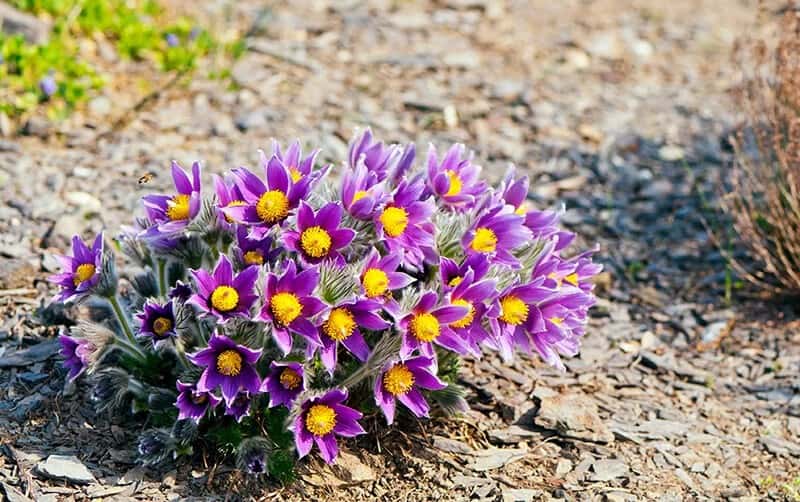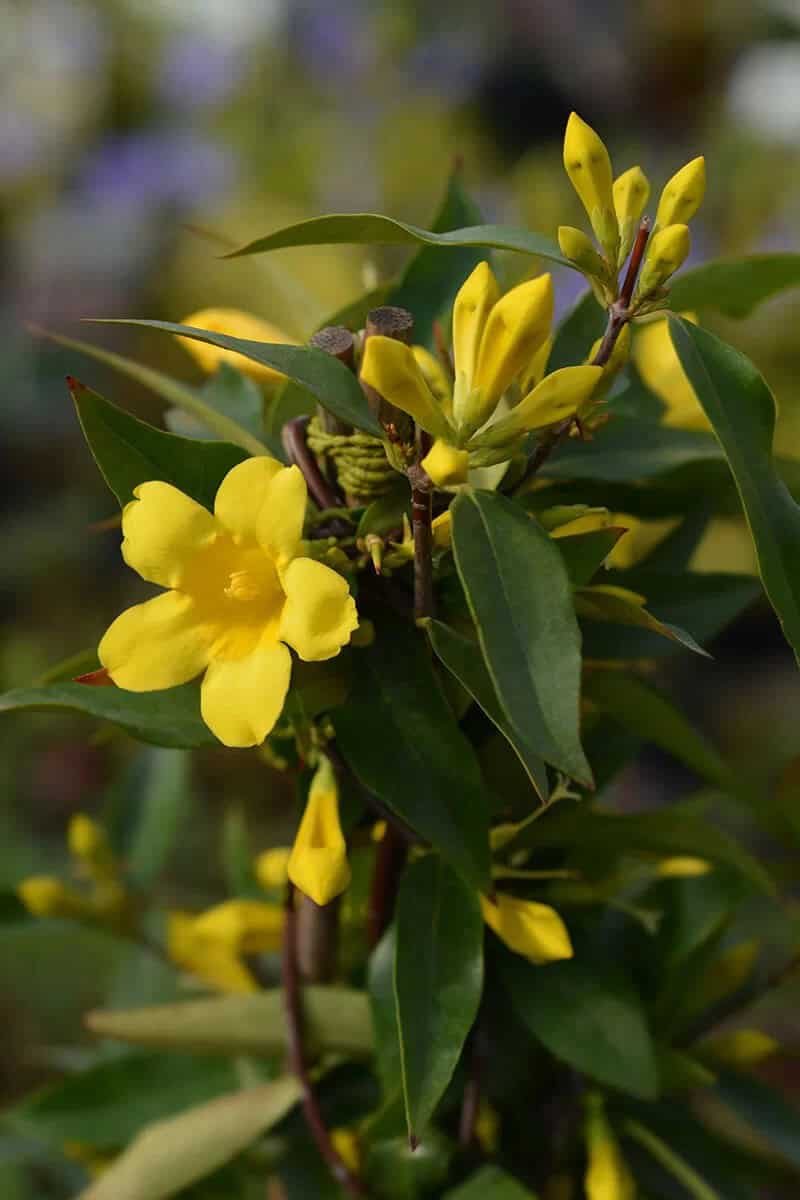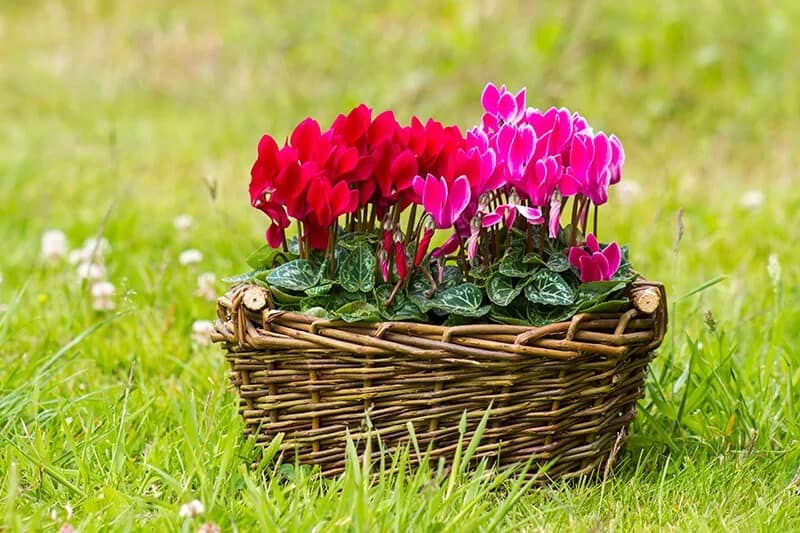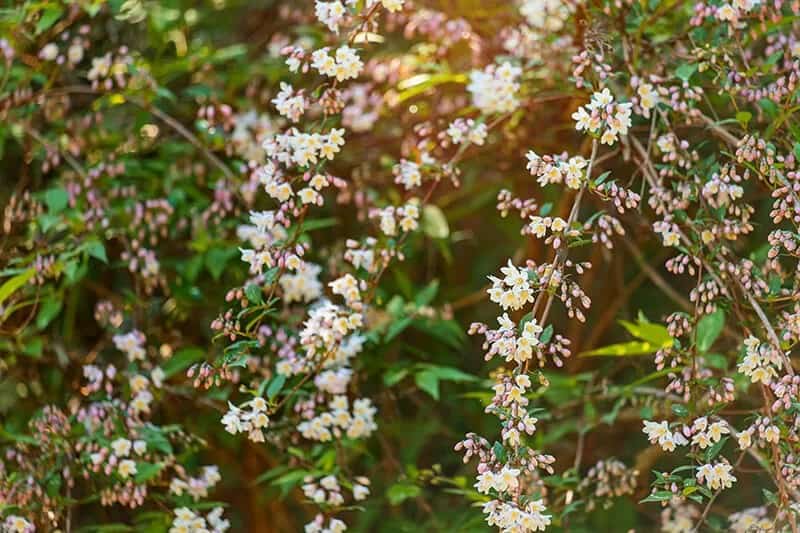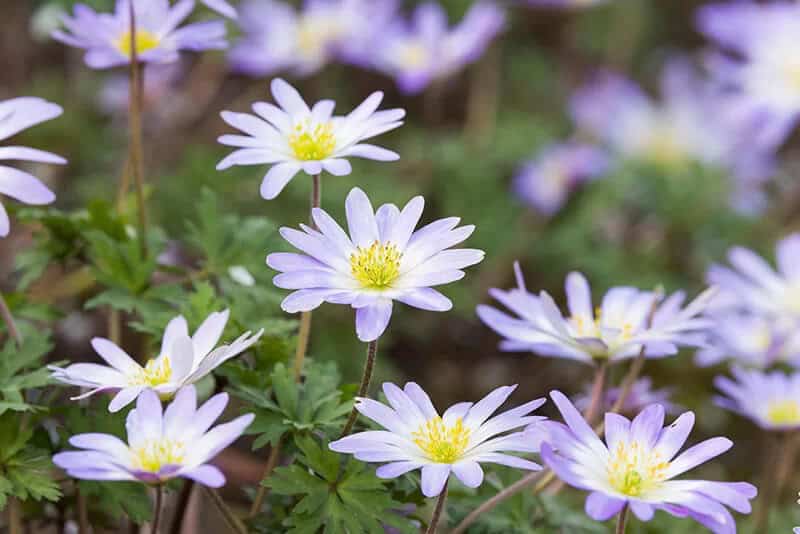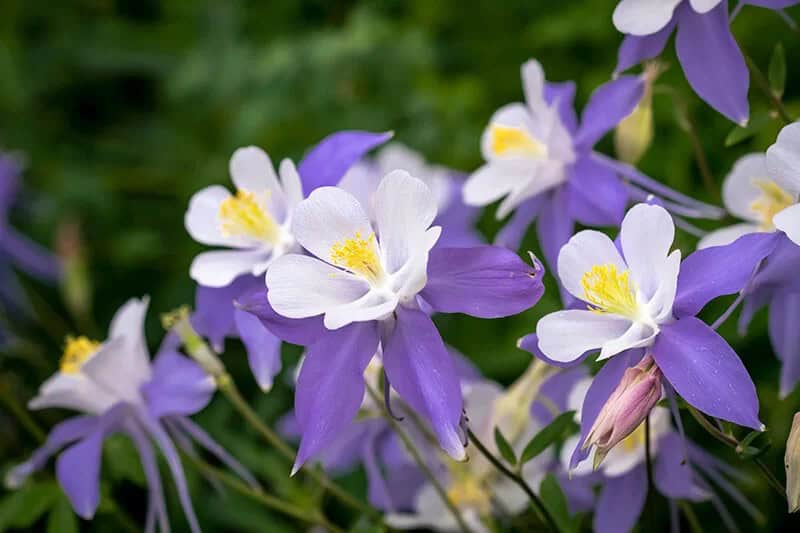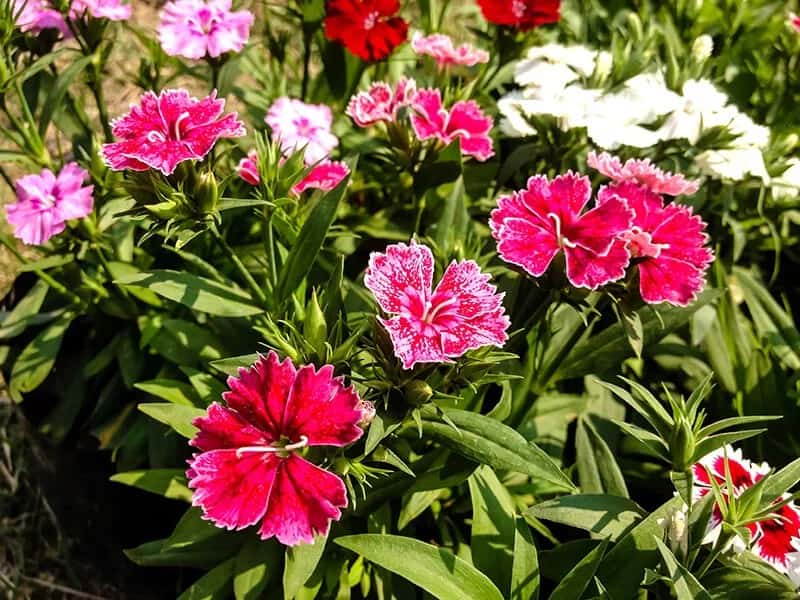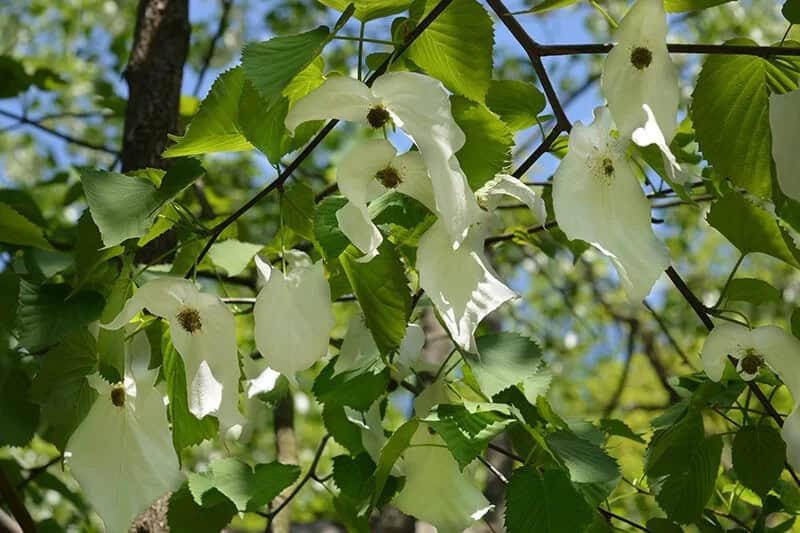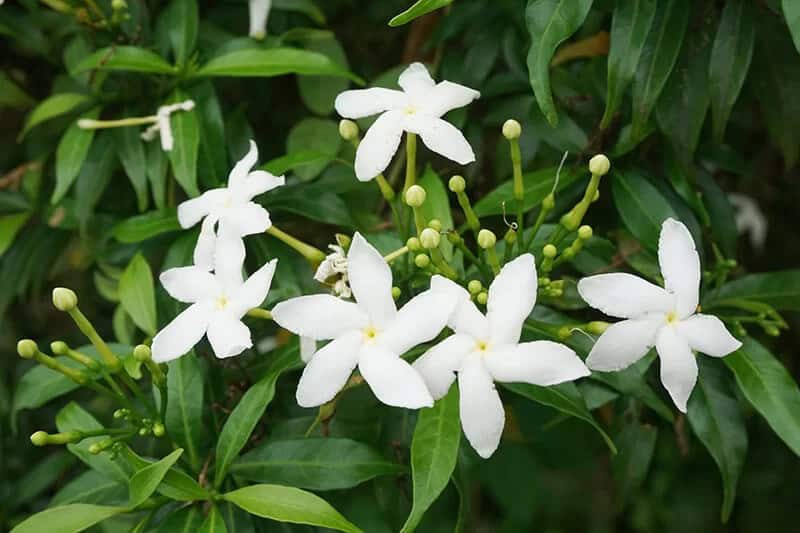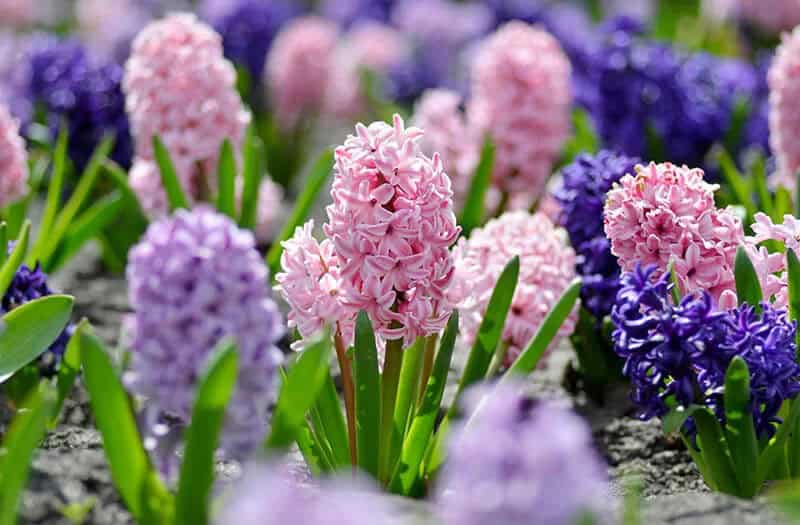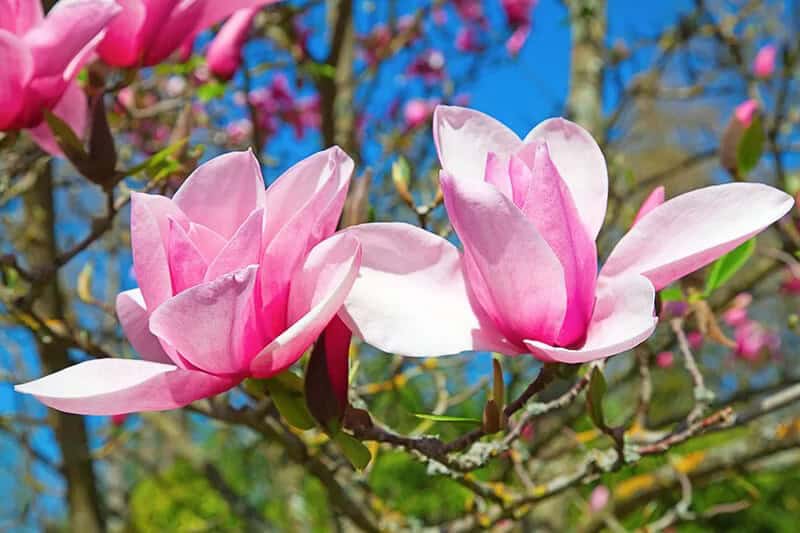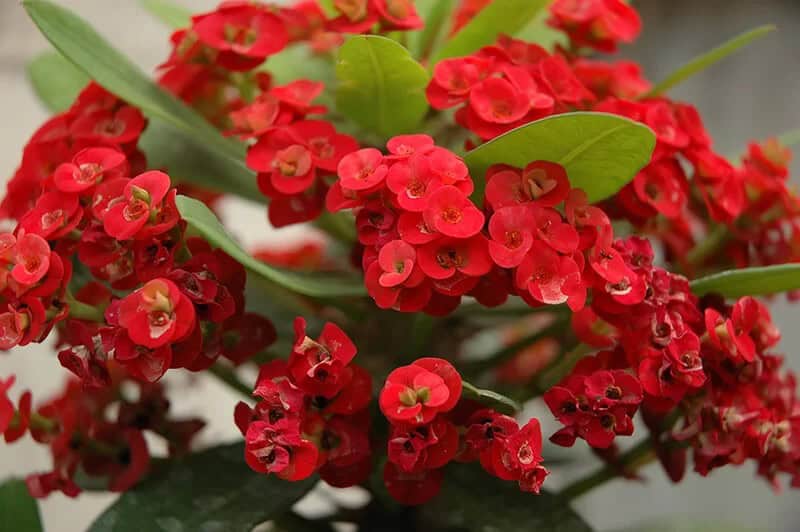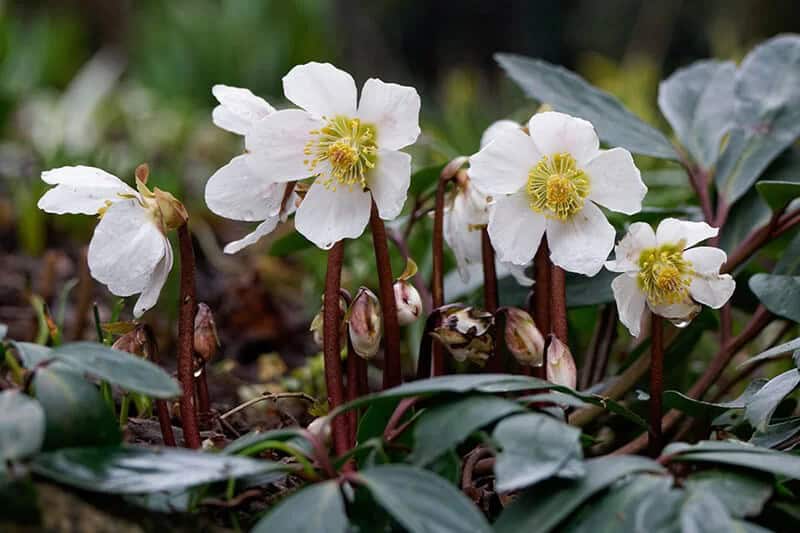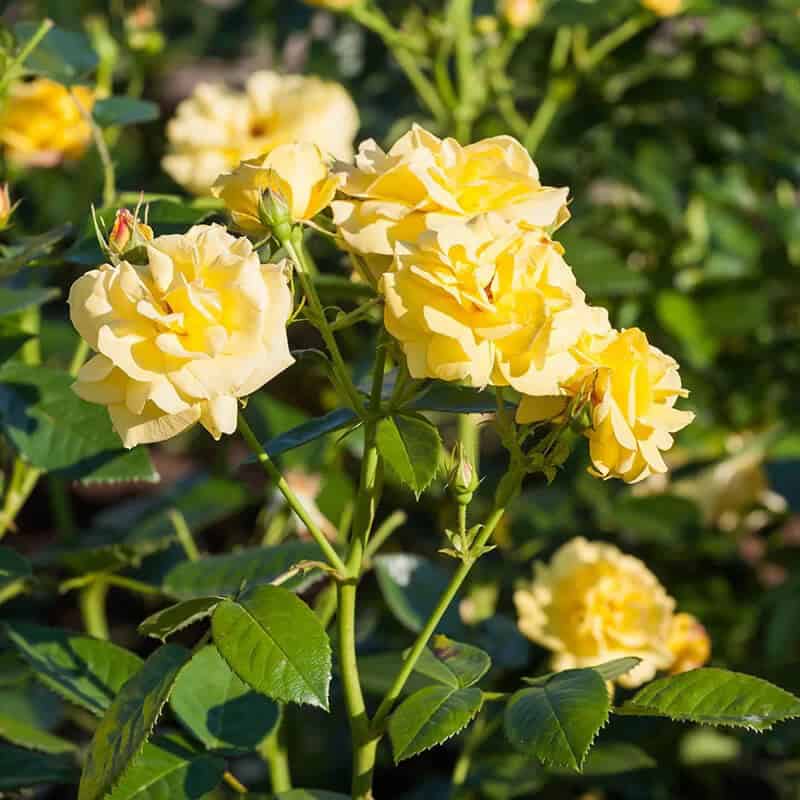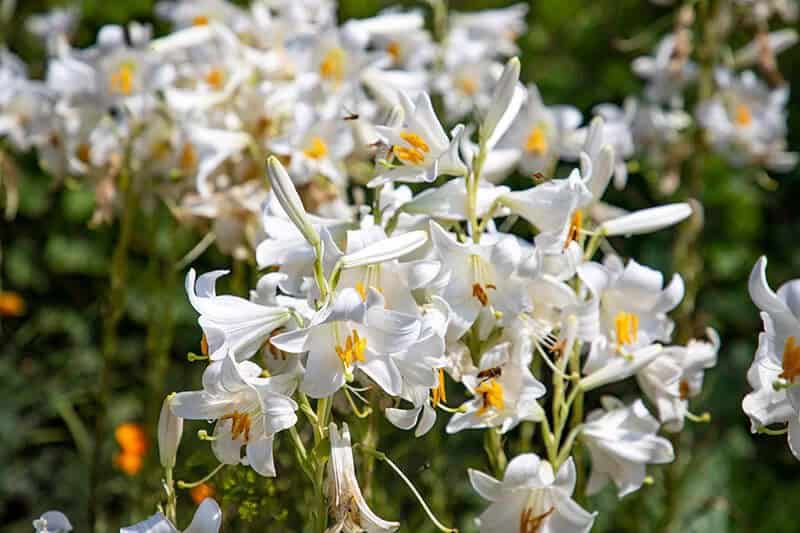When Easter falls in the spring, its unpredictable timing can make it tricky to coordinate a garden featuring freshly bloomed Easter flowers. To sidestep this challenge, consider incorporating plants that bloom throughout March and April, ensuring a constant display of vibrant colors and fragrances in your landscape.
27 Most Fun Easter Flowers to Plant for Unforgettable Easter Egg Hunts
In the United States, Easter flowers serve a purpose beyond mere aesthetics. The annual tradition of Easter egg hunts often takes place outdoors, and having an array of vibrant flora on hand can elevate the experience. Large-leafed plants can create an immersive atmosphere, making the hunt feel like a true treasure trove, while colorful blooms can be strategically placed to cleverly conceal the eggs, adding an extra layer of excitement to the search.
Large-Cupped Daffodil (Narcissus ‘Easter Morn’)
Easter wouldn’t be complete without the vibrant blooms of daffodils, a staple in many spring gardens. These low-maintenance flowers are remarkably consistent in their blooming schedule, making them a reliable choice for any gardener. To ensure that your daffodils burst forth with color at Easter time, consider planting varieties that have different bloom times.
This way, you’ll be treated to a stunning display of white-on-white petals, perfectly complementing other Easter flowers and adding a touch of elegance to your springtime celebrations.
Eastern Pasque Flower (Pulsatilla Patens)
The Eastern Pasque flower is often associated with symbolism of contentment and Easter celebrations. This drought-tolerant species thrives in gritty soil with good drainage and can tolerate dry to medium water conditions. Gardeners in USDA Hardiness Zones 3-7 will find this full-sun loving bloom to be a great addition, as it produces vibrant purple and yellow flowers that can be gathered into clumps perfect for hiding Easter eggs.
The silvery sheen on the foliage is particularly striking when illuminated by early morning sunlight, adding an air of enchantment to these already magical blooms. What’s more, this frost-tolerant flower allows gardeners to enjoy its beauty well into March and April, making it a great choice for those who experience an early Easter.
Carolina Yellow Jasmine (Gelsemium Sempervirens)
Carolina Yellow Jasmine, an evergreen vine that bursts with trumpet-shaped flowers in early spring, is a delightful addition to any garden. With its medium water needs and rich soils that drain well, this flowering beauty thrives in zones 7 to 10, basking in full sun from dawn till dusk. Its cheerful yellow blooms appear from February to April, adding a splash of color to any landscape.
To enjoy these vibrant flowers at eye level, simply provide a structure for it to climb, as it naturally grows into a shrub-like shape and sprawls via runners if left untamed.
Persian Violet (Cyclamen Persicum)
Persian violets, with their symbolism of innocence, everlasting love, modesty, spiritual wisdom, and faithfulness, are a delightful addition to any garden. As an early Easter flower, they’re perfect for planting in the spring. With a range of colors including pink, lavender, and white, you can choose the hue that best matches your home’s decor. These charming flowers require medium watering, prefer light soil with good drainage, and thrive in zones 9 to 11.
While they love basking in part shade, they’re not demanding when it comes to sunlight. In fact, their blooming season typically runs from November to March, making them a great choice for adding some spring-like charm to your winter garden. And the best part? They’ll stop growing and go dormant in the spring, only to burst back into bloom come fall.
Tulip (Tulipa)

Tulips, the quintessential Easter flowers, exude drama and vibrancy with their kaleidoscope of colors. As a symbol of perfect and deep love, they are often associated with springtime celebrations. With their unique, egg-shaped blooms, it’s no wonder why they evoke a sense of whimsy and joy. The good news is that tulips come in every color except true blue, making them an ideal choice for outdoor decor enthusiasts.
When it comes to growing conditions, tulips require medium watering needs, fertile soil with good drainage, and full sun exposure. They thrive in zones 3 to 8, and their blooming season typically occurs from April to May.
White Forsythia (Abeliophyllum Distichum)
White Forsythia’s understated beauty makes it an ideal choice for adding depth to your landscape design. With its symbolism tied to obedience, spring sunshine, and anticipation, this medium-watered, drought-tolerant shrub thrives in average soil with good drainage. Growing zones 5 to 8 accommodate its full sun to part shade requirements, allowing it to burst into bloom from March to April.
The prolific white flowers may not be the showstoppers of Easter arrangements, but they provide a thoughtful backdrop that pairs well with other blooms. For an striking border, consider alternating white and yellow forsythia for a unique visual interest.
Sapphire Anemone (Anemone Blanda)
Add a touch of soft elegance to your Easter landscape by incorporating the sapphire anemone. This delightful flower forms a charming, carpet-like mat in the spring, as if it was intentionally designed for Easter egg hunts. While blue may not be the perfect hue for every palette, you can also experiment with white, pink, and purple-tinged red varieties to find the perfect fit for your design.
This lovely flower requires medium water needs, rich soil with good drainage, and full sun to part shade. Its growing zones are 5 to 8, making it an ideal addition to many spring gardens.
Columbine (Aquilegia ‘Dove’)
The symbolism behind columbine is deeply rooted in spirituality, representing peace, endurance, and perseverance. This beautiful variety boasts pure white petals, making it a stunning addition to any Easter landscape. Its unique, sculpture-like flower structure is often captivating, even without relying on bright colors. With medium water needs, average soil that drains well, and thriving in zones 3-9, columbine is an ideal choice for many gardeners.
It prefers full sun to partial shade and blooms from April to May, making it a lovely sight to behold during the spring season.
French Mignonette (Dianthus Chinensis)
The French mignonette boasts an array of bicolor blooms, showcasing vibrant pinks alongside soothing whites. This charming Easter flower thrives in conditions that balance dryness with moderate watering needs, tolerating drought-like situations without faltering. Average soils with good drainage are ideal for growth, though it also accommodates clay soil. As a hardy perennial, French mignonette excels in USDA growing zones 6 to 9.
In terms of light exposure, full sun to partial shade provides the perfect environment for it to flourish. Its blooming season typically falls within April and June, with a prolific display of expressive yet airy flowers that can be mass-planted to create a whimsical carpet of color.
Camellia (Camellia Japonica ‘April Dawn’)
A stunning addition to any landscape, Camellia shrubs boast evergreen foliage and vibrant blossoms that can brighten up even the most mundane setting. Unlike many of its species which bloom in summer, ‘April Dawn’ stands out with its large, intricately patterned flowers that make a grand appearance around Easter time. The unique beauty of these blooms is reminiscent of hand-painted artwork, adding an artistic flair to your garden.
With medium water needs, acidic soils and good drainage, and growing zones 6-9, this shrub thrives in part shade conditions.
Flowering Dogwood (Cornus Florida)
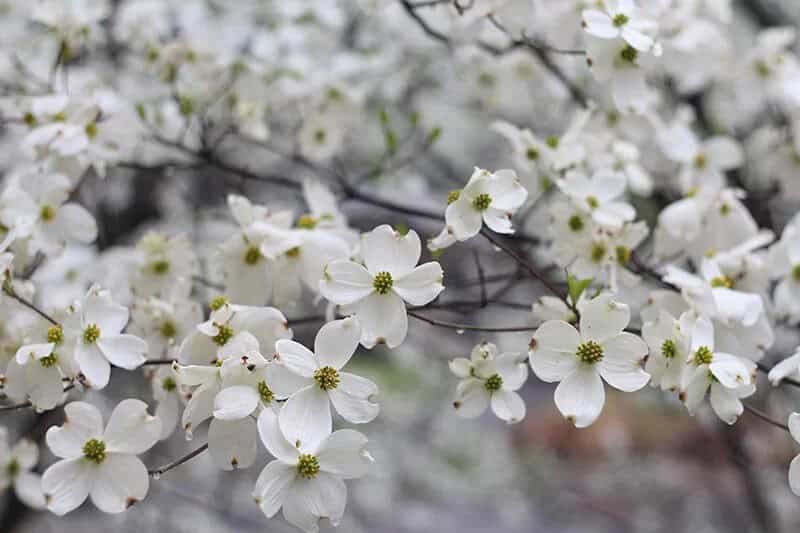
When creating an Easter-themed landscape, consider incorporating a flowering tree like the dogwood, which not only provides a stunning backdrop but also offers a unique hiding spot for Easter eggs. For added visual interest, layer flowers at varying heights to create dimension in your design. While white-flowering dogwoods are commonly depicted in images, it’s worth noting that red and pink varieties are also available.
The dogwood tree thrives in medium water conditions and tolerates clay soils with good drainage, making it suitable for zones 5-9. It requires full sun to part shade and blooms from April to May. With its symbolic associations with spring, rebirth, and soothing qualities, the dogwood is an excellent choice for Easter-inspired landscaping.
Spring Crocus (Crocus Vernus ‘Striped Beauty’)
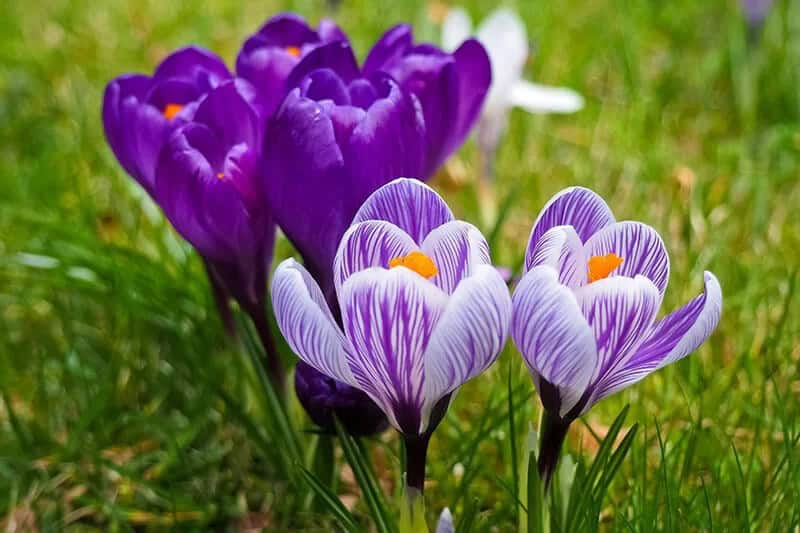
The ‘Striped Beauty’ crocus is a harbinger of spring’s arrival, its delicate purple lines on a cool white background serving as a visual representation of the season’s youthful energy and joy. This low-maintenance flower thrives in medium water conditions, tolerates average soil with good drainage, and can even survive in clay-rich soils. Gardeners in USDA zones 3 to 8 can cultivate this beauty, which requires full sun to partial shade and blooms from March to April.
For three weeks during early spring, the crocus’s vibrant colors – including rich purple and joyful yellow-orange hues – add a pop of vibrancy to any garden.
Handkerchief Tree (Davidia Involucrata)
The handkerchief tree (Symbolism: Enigma, sacrifice and peace) is a unique addition to any landscape, especially when it comes to providing visual interest. With its ability to grow up to 40 feet tall, this tree can be a stunning focal point in your outdoor space. Unlike other trees that produce showy white flowers, the handkerchief tree offers drooping white bracts that reach up to 7 inches long.
As they flutter gently in the breeze, these bracts add a touch of whimsy and elegance to your landscape design. For optimal growth, this tree prefers medium water needs, rich soils with good drainage, and full sun to part shade. It thrives in USDA growing zones 6 to 8, and its blooming season typically occurs from April to May.
Gardenia (Gardenia Jasminoides)
Beyond their striking white beauty, Gardenia flowers offer a delightful, perfume-like fragrance that fills the air. They thrive in well-draining acidic soil with humus content, and can be grown in containers or directly in the ground. With a moderate water requirement and part shade to full sun, these Easter flowers are adaptable and easy to incorporate into any spring landscape. As summer arrives, their evergreen foliage provides ongoing visual appeal.
Blooming from April to June, Gardenia’s fragrance and beauty make them a delightful addition to your garden.
Dutch Hyacinth (Hyacinthus Orientalis)
Hyacinths are a beloved springtime symbol, radiating playful, peaceful, and committed energy through their vibrant hues and potent fragrance. This Easter classic boasts an impressive range of colors, from soft pastels to bold statements. If you’re struggling to choose just one shade for your space, consider ETOUFFEE’s delightful mix of pink, lavender, and blue varieties.
Their symbolic meanings extend beyond beauty and pride, also conveying power and strength.
To cultivate these stunning blooms in your own garden, ensure they receive medium water needs, average soil with good drainage, and full sun exposure. Hyacinths thrive in zones 4 to 8 during the spring blooming season from March to April.
Magnolia (Magnolia ‘George Henry Kern’)
Magnolias are often associated with grandeur and elegance, as evidenced by their stunning spring displays. These trees require some planning to incorporate into your outdoor space, but the vibrant blooms around Easter are well worth the effort. If pink isn’t quite your cup of tea, you can also find magnolias in shades of yellow, purple, or white. With a rich, slightly acidic soil and good drainage, these trees thrive in zones 5 to 8. They prefer full sun to partial shade and medium water needs.
In the blooming season of March to April, they showcase their hidden beauty, symbolizing virtues like nobility, perseverance, and love for nature. As you gaze upon their grandeur, remember that magnolias are a true delight of the natural world.
Baby’s Breath (Gypsophila Paniculata ‘Bristol Fairy’)
The symbolism behind baby’s breath is rooted in everlasting love, a sentiment that resonates deeply with its delicate yet abundant blooms. This charming plant thrives in dry conditions and alkaline soils with good drainage, making it an ideal choice for gardeners in zones 3 to 9. As the sun shines bright (full sun required), baby’s breath comes alive from April to August, blanketing its surroundings with a mist of tiny white flowers that beautifully complement more showy blooms.
Despite being the understudy, baby’s breath proves to be a perfect hiding spot for Easter eggs or adding a touch of whimsy to cut flower arrangements, solidifying its place as one of the most charming Easter flowers.
Sweet Alyssum (Lobularia Maritima ‘Snow Crystals’)
Enveloped in a tapestry of pure white blooms that practically conceal the foliage, sweet alyssum brings an air of enchantment to a spring garden. Its mat-forming habit makes it an ideal choice for groundcover, where its delicate flowers can unfurl to create a captivating display. With various cultivars offering purple, pink, and apricot hues in addition to its classic white shade, this Easter flower is sure to delight.
Under the right conditions – moderate watering, well-draining soil, full sun to partial shade, and a growing zone between 5 and 9 – sweet alyssum’s beauty can be savored from April until the first frosts of autumn.
Crown of Thorns (Euphorbia Milii)
The vibrant red blooms of the crown of thorns plant are a sight to behold, and their appearance depends on your climate and the plant’s location. Whether grown indoors as a houseplant or in an outdoor garden setting, these woody succulents typically produce flowers from late winter through the fall. It’s essential to exercise caution when handling the plants, as they are equipped with sharp thorns that can cause injury.
To avoid any unwanted scratches, it’s recommended to wear protective gloves while tending to your crown of thorns. With a range of growing zones spanning 9 to 11, and requirements for good drainage, full sun, and water that’s neither too dry nor too moist, this plant is well-suited to thrive in warm climates.
Cowslip (Primula Veris)
Cowslips may appear like understated Easter flowers at first glance, but they bring a touch of sunshine to shaded areas with their bright yellow blooms. When used as edging or to define a border, cowslips add a sense of elegance to outdoor spaces without overpowering the surrounding scenery. These flowers thrive in medium-moisture environments and prefer humus-rich soil, although they can tolerate boggier conditions.
With a growing zone range of 3-8 and part shade requirements, cowslips are a versatile choice for many gardens. In late spring (April-May), cowslips burst forth with simple yet charming flowers that symbolize adventure, mischief, and the beauty of simplicity.
Lenten Rose (Helleborus ‘Brushstrokes Strain’)
The Lenten rose, also known as Helleborus, is a striking and expressive perennial that thrives in medium water conditions. Its unique cup-like flowers are adorned with vibrant patterns, which can resemble streaks, splashes or spots depending on the bloom. Noted for its decorative flair, this variety excels at expressing itself through color.
With its hardy and perennial nature, it’s no wonder why Lenten roses have become a popular choice among gardeners seeking serenity and tranquility in their outdoor spaces. The ideal growing conditions for these plants include fertile, slightly alkaline soil, partial to full shade, and temperatures between zones 4 to 9. A blooming season typically occurs from March to May, filling the air with an aura of peace and calm.
Azalea (Rhododendron ‘Hoosier Rose’)
Azaleas are renowned for their vibrant displays of blooms, making them a sought-after addition to spring gardens. Beyond their seasonal splendor, flowering azalea bushes also offer a unique opportunity for interactive fun during Easter egg hunts. The delicate hues of these flowers are further accentuated by subtle spot patterns. Azaleas require rich soils with good drainage and thrive in zones 4 through 8, where they can be grown in part shade conditions.
They enjoy medium water levels, making them relatively low-maintenance. In terms of blooming season, azaleas typically reach their peak in April and May.
Iris (Iris ‘Katharine Hodgkin’)
The ‘Katharine Hodgkin’ iris is a stunning addition to any spring garden. With its delicate blue and yellow colors, freckled petal structure, and upright growth habit, this petite bloom (only 6 inches tall) packs a big punch. Its symbolism is equally impressive, representing victory, vitality, wisdom, hope, trust, and valor. To thrive, irises like ‘Katharine Hodgkin’ require medium watering, average soil with good drainage, and can be grown in zones 5 to 9.
They prefer full sun to part shade and bloom from March to April, making them a great choice for adding a splash of pastel blue to your garden.
Large-Flowered Climbing Rose (Rosa ‘Lawrence Johnston’)
The Lawrence Johnston climbing rose is a unique variety that offers large, bright yellow blooms in the springtime – specifically from April to June. This vigorous climber thrives when provided with a trellis, fence, or pillar to support its growth. While it’s adorned with showy flowers, gardeners should be aware that this rose also comes equipped with thorns. When it comes to growing conditions, the Lawrence Johnston prefers acidic soil with good drainage and full sun.
It’s suitable for USDA zones 5-9, and requires medium watering levels.
French Lilac (Syringa Vulgaris ‘Agincourt Beauty’)
Fragrant French lilac is a reliable bloomer that can add a touch of elegance to any spring garden. Its purple flowers are not only visually stunning but also highly fragrant, making it an excellent choice for an Easter celebration or as a specimen plant in your garden. When used as a hedge, this variety is particularly impressive, with its large, showy blooms adding texture and interest to the surrounding landscape.
Pyrenean Violet (Viola Cornuta)
The Easter-perfect Delphinium: A Symbolic Blooms With Unique Characteristics This perennial bloom originates from the Spanish Pyrenese mountains, arriving in a palette that harmoniously welcomes the Easter season. In April, delicate petals showcasing hues of violet, white, blue, and yellow unfurl, signaling the start of the blooming season. One of its most endearing qualities is its ability to attract butterflies.
In terms of growing conditions, Delphinium requires medium water needs, thriving in humus soil with good drainage. It thrives in zones 6 to 11, where it can bask in full sun to part shade, making it an ideal addition to any garden.
Zephyr Lily (Zephyranthes Simpsonii)
A symbol of anticipation, hope, and new beginnings, zephyr lilies bring a touch of elegance and sophistication to any space with their graceful white petals. While Easter lilies may not bloom during Easter if grown outdoors, zephyr lilies thrive in spring’s full sun to part shade, making them a perfect addition to your garden or indoor decor. With medium water needs, sandy soil with good drainage, and a growing zone of 7 to 10, these charming flowers are low-maintenance yet high-reward.
In fact, they bloom throughout the spring season, from February to May, providing a continuous display of beauty and serenity.
27 Vivacious Easter Flowers to Plant for an Energizing Springtime Landscape
As Easter approaches, gardens around the world take on a unique character. For those who observe this holiday as a time for religious celebration, the focus often falls on crisp white blooms that evoke a sense of purity and reverence. On the other hand, families hosting Easter egg hunts might prioritize vibrant flowers with lush foliage to create an engaging obstacle course for their little explorers.
Regardless of how you choose to celebrate, selecting flowers that speak to your personal connection with Easter will bring joy and beauty to your outdoor space. By planting your favorite blooms in early spring – think March and April – you’ll be treated to a stunning display of color and texture throughout the Easter season. From delicate snowflake-inspired petals to bold, bright explosions of color, there’s an array of options to suit every taste.

